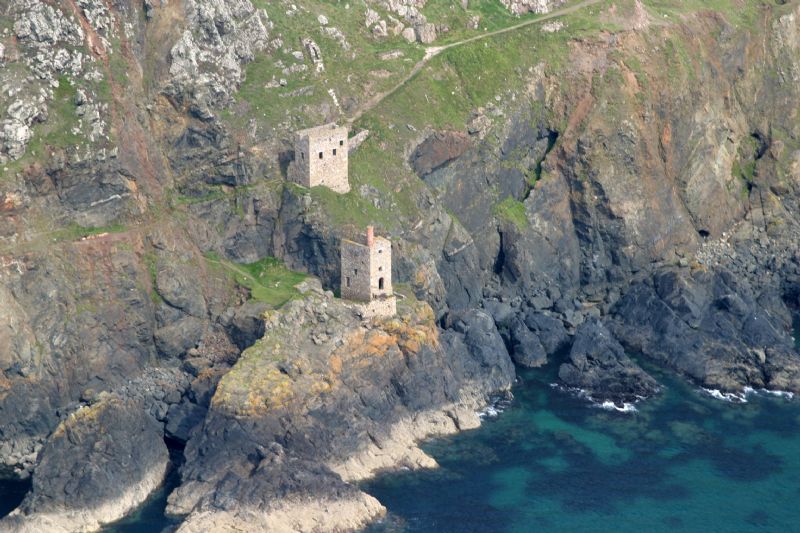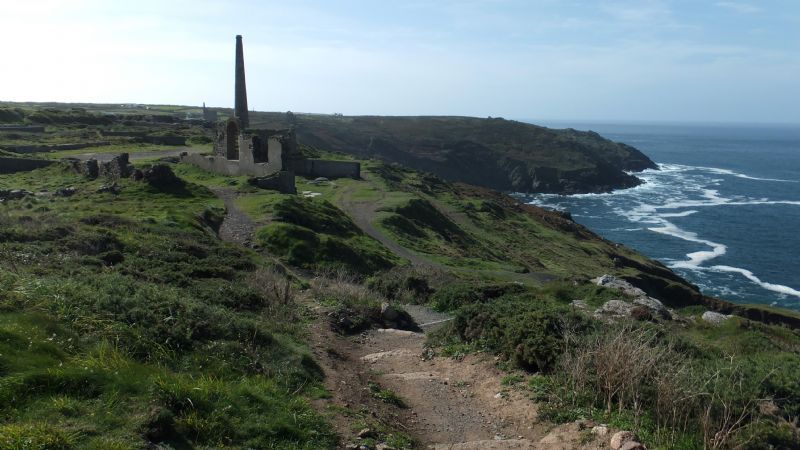Levant to Botallack
Walk
Cornwall Coast Path
Cornwall Information & Accommodation Guide

Levant to Botallack
This section of the coast path takes you from Levant along rocky cliffs further into the St Just Mining District, now designated as a Cornish Mining World Heritage site. Much of this part of Cornwall's coastline was used in the filming of the latest series of Poldark. The mines along this walk featured as Ross Poldark's Wheal Leisure.
Levant engine houses stand perched on the edge of cliffs.
The Levant steam engine is the only Cornish beam engine in the world that is still operating on its original mine site.
The chasm in the cliff which falls away to the sea below is Levant Zawn. Zawn is from the Cornish word sawen or saven, meaning a deep and narrow sea inlet with steep sides.
The rock here is killas slate.
The coast path continues past Carn Du, from the Cornish words for Black Carn, on past a disused quarry to another rocky crag, Carn Vellan.
The cliffs along this stretch of the coast path are very popular with climbers. There are many established climbs.
The next feature along the path is Stamps an Jowl Zawn on Roscommon Cliff. Stokesite was discovered here in 1899. In the cliff below you is a natural arch.
A small stream rushes over the cliffs here creating a small waterfall.
Evidence of the mines that used to operate here are all around you in the landscape - shafts now capped or walled and spoil tips. You are now in the area which was formerly Wheal Cock, a tin and copper mine, before it became part of the Botallack sett. The flattened dumps of Wheal Hen are also here.
The coast path is now crossing Botallack Head and you are fast approaching the view of the Crowns' engine houses perched on the Crowns Rocks.
The Crowns' are probably the most photographed engine houses, located in
such a magnificent setting.
The remains of the chimney stack on Botallack Head are all that is left of the Crowns whim. The engine which stood here hoisted ore from Boscawen incline shaft. Named after the family name of Lord Falmouth, the mineral lord of Botallack.
De Narrow Zawn is the next feature in the cliffs. It is believed to be from the Cornish words, 'sawn' meaning 'sawn' (see above) and 'dynarow' meaning 'pounds'. This is fitting as the De Narrow Zawn contains a very rich tin vein.
The path then passes Zawn a Bal, meaning the Mine-working Zawn.
There are a huge amount of disused mine buildings and chimney stacks remaining here, giving you the opportunity to explore the ruins and get a good idea of the processes involved in extracting and processing minerals such as tin and arsenic.
You can make a detour here to visit Botallack village, where there is a pub, The Queens Arms, great for a drink and a meal before proceeding along the next section of the coast path.
Public Transport
Bus service A17 between Penzance and Lower Boscaswell. All Year Round
Service operated by First Kernow
Visit Cornwall Public Transport for latest timetables
OS Explorer Map 102 - Land's End, Penzance and St Ives
All ATMs throughout Cornwall.
If the information on this website has been useful to you please consider a donation.
This easy to use travel planner makes it simple. Just add the location in Cornwall from where you are travelling and the destination you wish to travel to and it will provide full details of times, buses, trains and ferries to get you to your destination.
Books online:
Click here to buy books online about Levant to Botallack - Walk - Cornwall Coast Path
Find all the Dog Friendly beaches in Cornwall
More archaeological sites in Cornwall
Places of interest in or around Levant to Botallack - Walk - Cornwall Coast PathTowns, villages and other locations |
Cornish phrases and place names |
Topical phrases of the month October: 'Festival Phrases'
Place Name of the Month October: Karrekreun – Cargreen

|
Levant to Botallack - Walk - Cornwall Coast Path Map |
|
Levant to Botallack - Walk - Cornwall Coast Path Events |
|
Levant to Botallack - Walk - Cornwall Coast Path Community Information |
|
Levant to Botallack - Walk - Cornwall Coast Path Books |
|
Levant to Botallack - Walk - Cornwall Coast Path Photos |
|
Levant to Botallack - Walk - Cornwall Coast Path Videos |
|
Levant to Botallack - Walk - Cornwall Coast Path History |
Levant to Botallack
Walk
Cornwall Coast Path
Accommodation
Businesses
in or around Levant to Botallack - Walk - Cornwall Coast Path
Things to do
in this area

|
|







